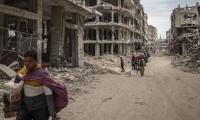[Continued from ‘Aqleemas’ revolt in the arid land’ (March 12, 2019). The readers are advised to first read ‘I am a woman born of a woman’]
We now move on to another poem, ‘I am a woman born of a woman’, written by an anonymous working class Chilean woman in 1973. This poem is not the one voice of the women of feminism. It is two voices from the same gender but different classes. It knows no sisterhood based on gender affinity. It is imbued with an understanding of the fundamental antagonism between men and women of the propertied and exploiting classes on the one hand and men and women of the labouring and exploited classes on the other. The anonymous woman gives a soul-stirring expression to her pleasure of living the socialist dream and her pain of living through the nightmarish reaction to it in the form of a bloody class war waged on the working classes.
Chile’s president (1970-73) Salvador Allende’s policy of nationalisation and collectivisation offended the capitalists, the landlords and the Chilean army whose leadership comprised CIA-trained professional and political reactionaries. The subsequent tragedy was one particularly brutal example of US-backed crimes against humanity perpetrated throughout Latin America in the 1960s and 70s to install fascistic dictatorships that defended the interests of imperialism and capitalism against the working classes. On September 11, 1973 General Augusto Pinochet and his forces committed a bloody coup in collusion with the Nixon administration, the CIA and the Pentagon. Allende died and thousands and thousands of workers, students and left activists were murdered. Thousands more ‘disappeared’, were tortured and hounded out of the country. Two decades of brutal dictatorship followed, turning Chile into a torture colony. In this backdrop, the ‘anonymous’ woman paints a picture of class contradictions between the lives of two women – one from the working class and the other the wife of a capitalist. Both women are born of women – a point that serves not to make them similar but to stress that their respective stories have remained the same through generations.
The capitalist husband wore silk and was concerned about his weight – probably a result of overeating. The working class husband wore “tattered clothing” with his “heart strangled by hunger.” We wonder why his heart and not his stomach. But we stop wondering when the working class wife tells us she “watched” two of her babies die without milk. We can imagine that she could neither buy milk nor produce it in her breasts, being plagued with hunger. Her three “surviving” children were also marked by hunger in their mal-developed bellies. This was the strangling pain she shared with her husband’s heart and not with the capitalist’s wife whose “beautiful” twins grew into “popular college students with summers abroad.”
The poem turns towards a socio-political struggle taking place. Both women had “a man” giving them different perspectives on what was happening. The bourgeois woman follows the line “there was a man” with the phrase “and he talked about.” This implies distance. The proletarian woman says “and he told me”, which negates social and personal distance. What the rich woman heard expresses a fear that the “peasants” would get “richer” and the rich would get poor. The use of the word “peasant” by a factory owner’s wife to describe all the poor shows her definition of the poor – the uncivilised and the uncouth. Class hostility is apparent and so is the limitation of social consciousness born out of this hostility. The man she heard was a political reactionary, perhaps the capitalist husband himself. In that case the distance implied in the bourgeois woman’s “I saw a man” lines would signify the nature of her relationship with a man who was worried that his class was fighting a battle it might lose and who was being made to come a little down the ladder of luxuries as a result of social and political change that had started taking shape.
The poor woman on the other hand was given good news – of better days to come and the bearer of the news “did make the days better.” The man who talked to her was either a left activist or perhaps her husband himself whose imagination and energy had been fired by the socialist ideal making him into a new, different man who was no longer strangled in his heart. He was full of vision and hope and filled her with vision and hope.
We get the vision – a reduction of privileges for the rich and a better life for the poor. The bourgeois woman now had to eat rice and beans and her children didn’t get to spend holidays abroad. The proletarian woman got what she never had before – rice and beans. Her children no longer cried themselves to sleep on account of hunger. What we notice here is the element of compromise sought between classes under Allende – a balance between dignity due to the working classes and the privileges and luxuries the rich thought they deserved. (The politics of class compromise characterised the so-called socialism of many ‘third-world’ countries in the 70s with essentially the same disastrous end, with the middle and upper-classes collaborating with US-backed ‘national’/neo-colonial armies to perpetrate coups on elected governments and crush peasants and workers).
A mountain of misery had not fallen on the bourgeois woman but she “felt like a peasant” with “a dull, hard, unexciting life.” Heaven had not opened its doors to the proletarian woman but she “felt like a woman” for the first time whose “life now sometimes allowed a song”. These lines are telling in the absence of any reference to gender in what is spoken by the bourgeois woman and in the emphasis on womanhood in the reflections of the proletarian woman. One felt reduced to the same sexless, defeminised and shabby creature she knows as the “peasant”, and the other felt femininity in her for the first time. Here we note an implicit agreement in both the voices about the state of working class womanhood. The proletarian womanhood is crushed, negated. The womanhood of the negated woman could only be achieved and affirmed by negating what the bourgeois woman perceives to be her womanhood. Bourgeois parasitic womanhood is made possible by depriving the proletarian woman of her womanhood.
There comes another turning point. The gradual improvement in the lot of the working classes had given them hope of freedom – from exploitation, want and misery. The politics of compromise between classes had not yet given the oppressed their freedom, only a hope. Even this was too much for the capitalists and the landlords who were now actively collaborating with the reactionary army and its imperialist backers so that they could return to their lost freedom. The yearning for and gaining of freedom in one class is only as good/bad as the loss of it in the other. Both women now again saw “a man” and, again, one was a reactionary with whom the capitalist wife plotted (like the rest of her class) the overthrow “someday” of the hope of freedom in the working classes and the other a man whose heart had begun to beat with the hope of freedom – “someday”. Then the army moved in both for and against freedom – to return freedom to the capitalist’s wife and to crush the hope of it in the woman of the working class.
The poem now becomes an increasingly horrid description of the coup – mass murder and rape visited upon the proletariat and the peasantry. Freedom was announced and “class brothers” of the bourgeois woman approached her along with her husband, whom she now describes as “my man”. The men of her class had won back their manhood and she her womanhood – bourgeois manhood and womanhood based on money relationships. Money had almost gone, but no more. They drank, danced and celebrated. This freedom invaded the home of the proletarian woman in the form of an organised mob of young boys – children, agents and soldiers of the capitalists and the landlords. They murdered the man who was her ‘my man’ and they butchered other men of her class. The murdered had collectively hoped that their life would eventually become theirs.
The poem’s climactic comparison of the fates of the women is intense and disturbing. Both descriptions are orgiastic – one erotic and the other all blood, gore and rape. The bourgeois woman and her “sisters” were “taken” – taken to dinner at a small private club and treated to beef, with one course after another.” The proletarian woman – “me the woman” as she describes herself – and her “sisters” were also “taken” – “and stripped of the dignity they had gained”. They were reduced to and treated as “beef” by the bourgeoisie and their army. “One after the other they came at them.”
“We were so full. Lunging, Plunging”, says the woman of the bourgeoisie. “Sisters bleeding, sisters dying”, recalls the woman of the proletariat. The recurring “sisterhood” in both voices has nothing to do with gender but everything to do with class. The bourgeois woman “felt magnificent to be free again”. The children of the bourgeoisie were given a party and good wine. The proletarian woman survived this freedom “without relief” – to see the children of her class amputated by her rapists.
The poem is a record of inhuman alienation of man from man, woman from woman under class rule, the rule of capital. It is a picture of humanity riven by a fundamental contradiction in its very essence. Part of the poem’s anti-climax is a reversion to the old order. The factory owner’s wife doesn’t have to eat beans and rice anymore. She has got her chicken and steak back. The working class widow doesn’t have her signs of hope anymore – her beans and rice. They have been replaced by hunger. For the rich woman “the parties continue, night after night to make up for all the time wasted.” The poor woman’s “silent tears are joined by the midnight cries of her children.” The factory owner’s wife feels like a woman again. The proletarian widow’s short-lived womanhood has been crushed, raped into nothingness, before it could blossom. Amid her silent tears, she hears others call her a ‘woman’.
The writer is a student of literature and philosophy at the Forman Christian College, Lahore.
Email: salmakhalid935@gmail.com
A health worker administers polio vaccine drops to a child during a door-to-door polio vaccination campaign in Lahore,...
Armed militants of the banned Tehreek-e-Taliban Pakistan pose for a photograph in Orakzai Agency. —...
An aeroplane of the national flag carrier of Pakistan is seen in this file photo. — AFPWhile Pakistan considers...
Representational image of a graph depicting various variables. — APP/FileInitiated by the centre and fiercely...
In this picture taken on April 16, 2023, people throng a market area during shopping in Lahore. — AFPOne of the...
Honour crimes also target men. In Sikandar Ali Lashari vs The State, SHC upheld conviction passed by ATC for honour...







